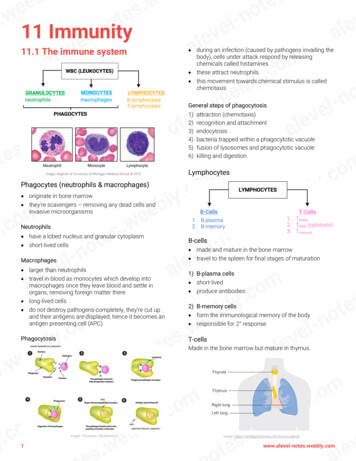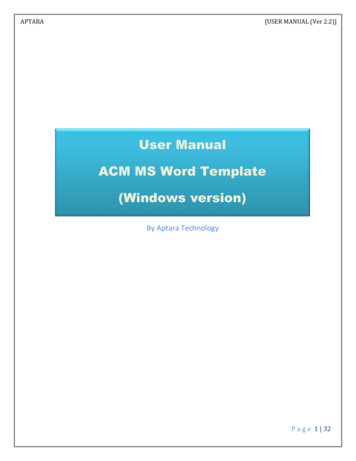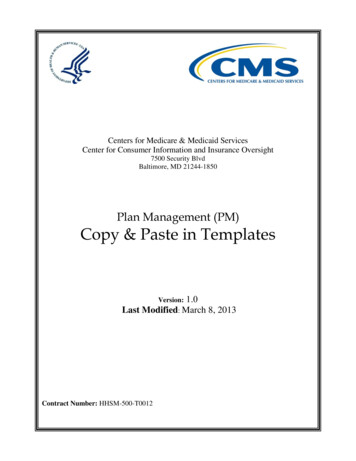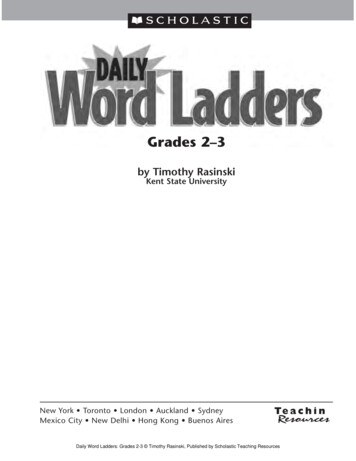
Transcription
11 Immunity11.1 The immune system during an infection (caused by pathogens invading thebody), cells under attack respond by releasingchemicals called histamines these attract neutrophils this movement towards chemical stimulus is calledchemotaxisGeneral steps of phagocytosis1)2)3)4)5)6)attraction (chemotaxis)recognition and attachmentendocytosisbacteria trapped within a phagocytotic vacuolefusion of lysosomes and phagocytotic vacuolekilling and digestionLymphocytesPhagocytes (neutrophils & macrophages) originate in bone marrow they’re scavengers – removing any dead cells andinvasive microorganismsNeutrophils have a lobed nucleus and granular cytoplasm short-lived cellsMacrophages larger than neutrophils travel in blood as monocytes which develop intomacrophages once they leave blood and settle inorgans, removing foreign matter there long-lived cells do not destroy pathogens completely, they’re cut upand their antigens are displayed, hence it becomes anantigen presenting cell (APC)PhagocytosisB-cells made and mature in the bone marrow travel to the spleen for final stages of maturation1) B-plasma cells short-lived produce antibodies2) B-memory cells form the immunological memory of the body responsible for 2 responseT-cellsMade in the bone marrow but mature in thymus.Image: Timonina / Shutterstock1Image: vel-notes.weebly.com
Thelper produce interleukins interleukins stimulate:1) B-cells to make antibodies2) other T-cells to divide3) macrophages to enhance the effect ofphagocytosis they can also increase the effect of phagocytosisÞT-lymphocytes can only recognise antigens on anAPC surfaceb) Humoral immunityTkiller (cytotoxic) destroys cells by releasing perforin which makes holesin the cell surface membraneTmemory leads to immunological memory of antigen responsible for 2 responseImage: https://www.researchgate.net/a) Clonal selectionImmunityProcess by which an antigen selectively binds to andactivates only those lymphocytes bearing receptors forthe antigen. In short, this is basically recognising andchoosing which B-cells to use. Thelper cell recognises B-APC and becomes activated,releasing interleukins to signal further actionsa) Cell-mediated immunityThis is where T-lymphocytes respond to altered cells(APC, cancer cells, cells that’ve been infected by viruses)b) Clonal expansion (proliferation)The rapid multiplication of B (or T) cell clones afteractivation by an antigen. ÞB-APC divides and differentiates into –1) plasma cells to make specific antibodies2) memory cells to prepare for 2 responseB-cells can respond to APC as well as pathogensdirectlyNumbers of white blood cells Neutrophils in the blood increases during bacterialinfections and whenever tissues become inflamed anddie Lymphocyte numbers increase during viral infectionsand TBImage: www.macmillanhighered.com1) macrophage engulfs pathogen and becomes an APC2) Thelper’s cell receptor, which is complementary to theantigen, binds to antigen on APC3) Thelper then releases interleukins interleukins stimulate B-cells to divide into plasmacells and produce antibodies in the humoralresponse2 leukaemias are cancers of these stem cells cells divide uncontrollably to produce many cells thatdon’t differentiate properly and disrupt production ofnormal blood cellswww.alevel-notes.weebly.com
Autoimmune diseasesOccurs when the immune system mistakenly identifiesself-antigens as foreign (non-self) and mounts animmune response against them. during the maturation of T-cells in the thymus, millionsof cells are destroyed as they have T-cell receptorscomplementary to self-antigens some of these cells evade destruction and areactivated to stimulate an immune response againstthe body’s own proteins starts as an attack involving antibodies and killer Tcells against certain parts of the bodyImage: /leukemia/ immature white blood cells are produced quickly,disrupting balance of components in blood as a result, the body does not have enough red bloodcells or platelets this causes anaemia and increases the risk ofexcessive bleeding the number of mature lymphocytes and neutrophilsdecrease, so susceptibility to infections increase the person is now said to be immunosuppressed attack can be localised in one organ or directedagainst the whole body e.g., Myasthenia gravis, rheumatoid arthritis, type 1diabetes, lupus, psoriasis, etc.Myasthenia gravis (MG)Immune response immune response – the complex series of responsesof the body to the entry of a foreign antigeninvolves the activity of lymphocytes andphagocytes antigen – substance that is foreign to the body andstimulates an immune response self – substance produced by the body that theimmune system does not recognise as foreign andtherefore does not stimulate an immune responseImage: https://healthjade.com/acetylcholine/ antibodies are produced against receptors on musclefibres for acetylcholine which is released by ends ofmotor neurones to stimulate muscle contraction people with MG have Thelper cells that are specific forcell surface receptors for acetylcholine non-self – any substance or cell recognised by theimmune system as foreign and stimulates an immuneresponse Thelper cells stimulate a clone of B-cells to differentiateinto plasma cells and secrete antibodies that bind toreceptor blocking transmission from motor neuronesRole of memory cells in long-term immunity muscle cells are not stimulated so muscle tissuestarts to break downRemain in the blood for years and cause long-termprotection. symptoms – muscle weakness treatment – drug that inhibits enzyme in synapsesthat breaks down acetylcholine increases itsconcentration so its action in stimulating musclecontraction lasts longer or surgical removal of thethymus gland11.2 Antibodies and vaccinationAntibodies globular glycoproteins have quaternary structure form group of plasma proteins calledimmunoglobulins3www.alevel-notes.weebly.com
Using monoclonal antibodies in diagnosis andtreatment of diseaseIn diagnosis used to locate position of blood clots used to locate cancer cells which have different cellsurface proteins and therefore can be detected byantibodies used to identify exact strain of virus or bacteriumcausing an infection, which speeds up treatmentIn treatment Hinge region – gives flexibility to bind around antigen Antigen binding sites – sequence of amino acids inthese regions make a specific 3D shape which bindsto one type of antigenFunctions of antibodies treatment of breast cancer – antibody binds tocancerous cells and marks them for destruction byimmune system treatment of rheumatoid arthritis (autoimmune) –antibody binds to proteins secreted by T-cells thatcauses damage to cartilage in joints and blocks itsactionTypes of immunity attach to flagella of bacteria making them less activeand easier for phagocytes to engulf cause agglutination (clumping together) of bacteria,reducing chances of spread punch holes in bacteria cell walls, causing them toburst when they absorb water by osmosis antibodies coat bacteria, making phagocytosis easieras phagocytes have receptor proteins combine with toxins, neutralising them (antitoxins) combine with viruses and bacterial toxins, preventingthem from entering or damaging cellsHybridoma method for the production ofmonoclonal antibodiesVaccinationVaccines preparation containing antigens which is used tostimulate an immune response artificially B-cells that divide by mitosis do not produceantibodies and plasma cells that secrete antibodies donot divide it may contain antigens in the form of live or deadmicroorganisms, harmless (attenuated organism),toxoid (harmless toxin), surface antigens monoclonal antibodies – identical copies of one typeof antibodyHow vaccines can provide long-term immunity1) antigen is injected into a mouse2) spleen cells which produce lymphocytes whichproduce antibodies are removed3) plasma cells from spleen are fused with cancer cellsor myeloma cells forming hybridoma cells that divideindefinitely4) they divide by mitosis and produce antibodies41) vaccine contains antigens that stimulate an immuneresponse2) macrophages take up virus by phagocytosis and actas antigen presenting cells (APC)3) lymphocytes bind to these and under clonal selection4) clonal expansion then occurs by mitosis5) memory cells are formed6) booster is used to further stimulate memory cellformationwww.alevel-notes.weebly.com
Poor response to vaccines due to – suffer from malnutrition and don’t have enoughproteins to make antibodies or clones of lymphocytes defective immune system and don’t developnecessary B and T cell clonesVaccination programmesEradication of smallpox Variola virus was stable, it didn’t mutate and changecell surface antigens vaccine was made from a harmless strain of a similarvirus – a ‘live’ vaccine is more effective infected people can be easily identified vaccine was freeze-dried and can be kept at hightemperatures for as long as 6 months didn’t affect animals – easier to break transmissioncycleHerd immunityHerd immunity interrupts transmission in a population sothat those who are susceptible never encounter theinfectious agents concerned.Why measles, cholera, malaria, and TB haven’t beeneradicatedAntigenic variationa) Antigenic drift – minor changes in the viral antigen,memory cells are still able to recognise them and starta secondary responseb) Antigenic shift – major changes in antigen structure currently there are no effective vaccines for diseasescaused by protocists as they’re eukaryotes with manymore genes. e.g., malaria; each stage has its own antigenÞmeasles – poor response by some children, needsseveral booster shotsÞcholera – many strainsÞmalaria – too many stages (antigenic variations)ÞTB – symptoms may not be shown5www.alevel-notes.weebly.com
Image: www.macmillanhighered.com 1) macrophage engulfs pathogen and becomes an APC 2) T helper's cell receptor, which is complementary to the antigen, binds to antigen on APC 3) T helper then releases interleukins interleukins stimulate B-cells to divide into plasma cells and produce antibodies in the humoral response











